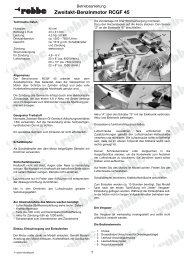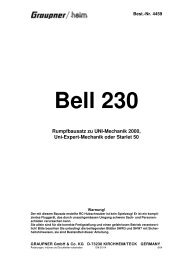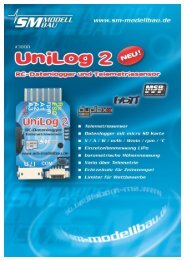Best.-Nr. 6492 Schaltnetzteil 12-30V; >30A Einführung 1 ... - RC-Toy
Best.-Nr. 6492 Schaltnetzteil 12-30V; >30A Einführung 1 ... - RC-Toy
Best.-Nr. 6492 Schaltnetzteil 12-30V; >30A Einführung 1 ... - RC-Toy
Create successful ePaper yourself
Turn your PDF publications into a flip-book with our unique Google optimized e-Paper software.
<strong>Best</strong>.-<strong>Nr</strong>. <strong>6492</strong> <strong>Schaltnetzteil</strong> <strong>12</strong>-<strong>30V</strong>; ><strong>30A</strong><br />
Breiter, einstellbarer Ausgangsbereich Konstantstrom<br />
<strong>Einführung</strong><br />
Bitte lesen Sie diese Bedienungsanleitung aufmerksam durch, bevor Sie erste Versuche zur<br />
Benutzung Ihres <strong>Schaltnetzteil</strong>s machen, denn nur so können Sie alle seine Möglichkeiten<br />
voll ausschöpfen. Achten Sie besonders auf die Warn- und Sicherheitshinweise. Bewahren<br />
Sie diese Anleitung an einem sicheren Ort auf; sollten Sie sich jemals von Ihrem Ladegerät<br />
trennen, geben Sie diese Anleitung bitte an den neuen Besitzer weiter.<br />
Dieses <strong>Schaltnetzteil</strong> ist klein, leicht und kompakt; es ist mit einer Strombegrenzung,<br />
universell verwendbaren 4mm-Buchsen für Bananenstecker und einer automatischen<br />
Stromregulierung ausgestattet. Es ist sowohl für die Stromversorgung als auch für das Testen<br />
Ihrer Ausrüstung geeignet. Es verfügt auch über eine Schutzschaltung, die Schäden an der<br />
Einheit oder an Ihrer Ausrüstung verhindern soll, um Fehlfunktionen durch Überspannungen<br />
zu verhindern. Das eingebaute Kühlsystem garantiert die volle Betriebssicherheit des Geräts<br />
und verhindert Überhitzung. Sie haben so eine perfekte Stromversorgung für <strong>12</strong>V-Ladegeräte<br />
und für Gleichstrom-Mini-Bohrmaschinen. Dieses Netzteil lässt sich auch als Lader für<br />
Bleiakkus verwenden.<br />
1. Technische Daten:<br />
Eingangsspannung: 220 ~ 240V AC 50Hz<br />
Netzstecker: SCHUKO-Stecker<br />
Ausgangs-Anschlüsse: Buchse für 4mm-Bananenstecker<br />
Ausgangsspannung: <strong>12</strong>V ~ 30 V DC (einstellbar)<br />
Ausgangsstrom: 0 ~ <strong>30A</strong> (einstellbar)<br />
Abmessungen: 260×190×105mm<br />
2. Besondere Merkmale:<br />
Überspannungssicher, kurzschlussfest<br />
Interne Kühlung durch Ventilator<br />
Maximale Ausgangsleistung einstellbar<br />
Pw =Vo×Io<br />
Vo: Ausgangsspannung (einstellbar)<br />
Io: Ausgangs-Kurzschlussstrom (einstellbar)<br />
Beleuchtete LC-Anzeige für Ausgangsspannung und Ausgangsstrom<br />
3. Betriebsanleitung:<br />
1. Betrieb als normale DC-Stromversorgung: Einstecken. Die Spannung mit dem<br />
Reglerknopf Spannung auf den gewünschten Wert stellen (<strong>12</strong> ~ 30 V). Das LC-Display<br />
die eingestellte Spannung auf dem Display an.<br />
Den Reglerknopf für die Stromstärke auf den gewünschten maximalen Stromwert<br />
einstellen. Das LC-Display zeigt den Strom an.
1.Lesen Sie vor Gebrauch die folgenden Abschnitte sorgfältig durch.<br />
2.Ziehen Sie den Netzstecker vom Netz ab, bevor Sie ein Gerät an das <strong>Schaltnetzteil</strong><br />
anschließen.<br />
3.Achten Sie beim Anschließen eines Geräts an das Netzteil auf die richtige Polarität.<br />
Rot ist Plus. Schwarz ist Minus. Achten Sie auf guten Kontakt.<br />
4.Schalten Sie das Netzgerät mit dem Schalter an der Gerätevorderseite auf “OFF”.<br />
Schließen Sie dann das Netzkabel an das Netz an.<br />
5.Schalten Sie das Netzgerät mit dem Schalter an der Gerätevorderseite auf “ON”. Jetzt<br />
leuchtet die LC-ANZEIGE und das Netzteil liefert Strom an das Gerät.<br />
Warnungen:<br />
1.Versuchen Sie nicht, das Netzteil zu öffnen, vor allem nicht, solange es an das Netz<br />
angeschlossen ist. Durch Öffnen erlischt die Garantie.<br />
2.Achten Sie auf die richtige Polung, wenn Sie ein Gerät an das Netzteil anschließen, da<br />
dieses Gerät sonst beschädigt werden kann. Schließen Sie kein Gerät an, das mehr als<br />
30 A Strom benötigt.<br />
3.Setzen Sie das Netzteil nicht Regen oder Nässe aus.<br />
4.Schließen Sie das Netzteil nur ans Netz an, wenn Sie es benützen wollen, sonst ziehen<br />
Sie den Netzstecker ab.<br />
5.Das Netzteil kann sich im Betrieb erwärmen oder leise brummen. Das ist normal und<br />
kein Anlass zur Besorgnis.<br />
6.Stellen Sie das Netzteil im Betrieb auf eine nicht brennbare Unterlage.<br />
7. Netzteil nicht im Freien benützen.<br />
2. Verwendung als Lader (Laden mit konstantem Strom und konstanter Spannung) :<br />
Charging Curve = Ladezustands-Kurve; adjustable area = Einstellbereich
Berechnung des maximalen Ladestromes und max. Spannung:<br />
Akkus laden Spannungsbereich Konstantstrom<br />
<strong>12</strong>V Bleiakku<br />
6V Bleiakku<br />
13.8V~14.2V<br />
6.9V~7.1V<br />
Akku Kapazität<br />
(1/5 ~ 1/10) x<br />
1h<br />
LiFe Akkupack 4 Zellen 14.0-14.4V<br />
Akku Kapazität<br />
(1 ~ 4) x<br />
1h<br />
LiPo Akkupack 3 Zellen <strong>12</strong>.3V<br />
LiFe Akkupack 3 Zellen<br />
LiPo Akkupack 2 Zellen<br />
10.6-10.8V<br />
8.2V<br />
Akku Kapazität<br />
(1/2 ~ 2) x<br />
1h<br />
LiFe Akkupack 2 Zellen 7.0-7.2V<br />
7Ah<br />
Beispiel: 6V Bleiakku: konstanter Strom = = 1.4A<br />
5<br />
WARN- UND SICHERHEITSHINWEISE<br />
Dieses Erzeugnis ist nicht für Kinder unter 14 Jahren geeignet, es ist kein Spielzeug! Es<br />
soll auch nicht von Personen mit eingeschränkten körperlichen, sensorischen oder<br />
geistigen Fähigkeiten oder ungenügender Erfahrung und Kenntnisstand benutzt werden,<br />
Kinder eingeschlossen, wenn sie nicht unter Aufsicht stehen oder wenn sie keine<br />
<strong>Einführung</strong> in den Gebrauch des Geräts durch eine für ihre Sicherheit verantwortliche<br />
Person erhalten haben. Kinder müssen beaufsichtigt werden, um sicherzustellen, dass sie<br />
nicht mit dem Gerät spielen.<br />
Schützen Sie das Netzteil vor Staub, Feuchtigkeit, Regen, Hitze (z.B. direkter<br />
Sonneneinstrahlung) und vor Erschütterungen. Es darf nur in trockenen Innenräumen<br />
benützt werden.<br />
Die Schlitze im Gehäuse dienen zur Kühlung des Laders. Sie dürfen nicht abgedeckt<br />
oder verschlossen werden. Stellen Sie das Gerät frei auf, so dass Kühlluft ungehindert<br />
zirkulieren kann.<br />
Das Netzteil ist ausschließlich für eine Stromversorgung an einer 220 ~ 240V AC<br />
Steckdose vorgesehen. Es ist nicht zulässig, das Netzteil in irgendeiner Weise zu<br />
verändern. Auf keinen fall dürfen Sie Wechselstrom an die Gleichstrombuchsen<br />
anlegen.<br />
Das Netzteil und der zu ladende Akku müssen vor Gebrauch auf eine wärmehemmende,<br />
nicht brennbare und nicht leitende Unterlage gestellt werden. Stellen Sie das Netzteil<br />
niemals auf einen Autositz, einen Teppich o. a. Halten Sie brennbare oder flüchtige<br />
Substanzen fern vom Ladebereich. Sorgen Sie für gute Durchlüftung. Schadhafte Akkus<br />
können explodieren oder brennen!<br />
Die Lade-Ausgangsbuchsen und die Ladekabel dürfen nicht verändert oder in<br />
irgendeiner Form zusammengeschlossen werden. Zwischen den Ladebuchsen und –<br />
kabeln und der Karosserie eines Wagens besteht Kurzschlussgefahr, wenn der Lader an<br />
die Autobatterie angeschlossen wird. Lade- und Verbindungskabel dürfen im Betrieb<br />
nicht aufgerollt sein. Vermeiden Sie Kurzschlüsse zwischen den Ladekabeln und dem<br />
Akku Ihres Modells und der Karosserie. Aus diesem Grund darf der Lader nie auf die<br />
Karosserie des Autos gestellt werden.<br />
Lassen Sie den Lader nie unbeaufsichtigt, wenn er läuft oder an die Autobatterie<br />
angeschlossen ist.<br />
Es darf immer nur ein Akku an einen Ladeausgang angeschlossen werden.<br />
Folgende Akkutypen dürfen nicht an den Lader angeschlossen werden:
Ni-Cd / Ni-MH Akkus, Bleiakkus mit einer Nennspannung von mehr als <strong>12</strong>V oder<br />
weniger als 6V Nennspannung, Lithium-Ionen / Li-Mn / Lithium-Polymer / LiFePO4<br />
(LiFe) Akkus mit weniger als 2 Zellen oder mehr als 3 Zellen (4 Zellen bei LiFePO4).<br />
Akkus, die nicht nach der CC/CV-Methode geladen werden dürfen, und Bleiakkus.<br />
Fehlerhafte oder beschädigte Akkus oder Zellen.<br />
Akkus, die aus parallel geschalteten oder aus verschiedenartigen Zellen bestehen.<br />
Akkus, die aus alten und neuen Zellen oder aus Zellen unterschiedlichen Fabrikats<br />
zusammengestellt sind.<br />
Nicht-wiederaufladbare Batterien (Trockenzellen). Vorsicht: Explosionsgefahr!<br />
Akkus, die vom Hersteller nicht ausdrücklich als geeignet für die von diesem<br />
Ladegerät beim Ladevorgang abgegebenen Ströme bezeichnet sind.<br />
Akku-Packs, die schon voll geladen oder heiß sind, oder nur teilentladen.<br />
Akkus oder Zellen, die mit einem integrierten Ladecontroller ausgerüstet sind.<br />
Akkus, die in ein Gerät eingebaut oder mit anderen Bauteilen elektrisch verbunden sind<br />
Zur Vermeidung von Kurzschlüssen zwischen den Bananensteckern an den Ladekabeln<br />
sollten Sie immer erst die Ladekabel an den Lader anschließen und erst dann an den zu<br />
ladenden Akku. Beim Abklemmen die Reihenfolge umkehren.<br />
Prüfen Sie grundsätzlich erst nach der Meldung des Laders, dass das Pack voll geladen ist,<br />
ob die Lademenge in etwa ihren Erwartungen entspricht. Dies ist eine einfache und<br />
verlässliche Methode, um rechtzeitig ein Problem zu erkennen, wenn der Ladevorgang aus<br />
irgendeinem Grund vorzeitig beendet werden muss. Die Wahrscheinlichkeit einer<br />
vorzeitigen Beendigung hängt von verschiedenen Faktoren ab, sie ist aber bei tief<br />
entladenen Packs, bei geringer Zellenzahl sowie bei bestimmten, als problematisch<br />
bekannten Zellentypen am höchsten.<br />
Wir empfehlen Ihnen, eine Serie von Test-Ladevorgängen durchzuführen, um sicher zu<br />
stellen, dass der automatische Ladeschluss richtig und zu Ihrer Zufriedenheit funktioniert.<br />
Das ist besonders dann der Fall, wenn Sie Packs aus wenigen Zellen aufladen. Wenn die<br />
Zellen eine schlecht definierte Spannungsspitze („voltage peak“) aufweisen, kann es sein,<br />
dass der Lader den maximalen Ladezustand nicht entdeckt.<br />
Bitte prüfen Sie vor dem Laden: Haben Sie den zum Akku passenden Lade-<br />
Ausgangsstrom gewählt? Sind alle Verbindungskabel fest angeschlossen oder gibt es<br />
irgendwo einen Wackelkontakt? Vergessen Sie bitte nicht, dass das Schnellladen von<br />
Akkus gefährlich sein kann. So führt zum Beispiel eine kurze Ladeunterbrechung<br />
aufgrund eines Wackelkontakts mit Sicherheit zu einem Fehler wie etwa einem Neustart<br />
des Ladevorgangs, was zu einer massiven Überladung des Packs führen würde.<br />
Gehen Sie sorgfältig vor! Ein Akku kann brennen oder explodieren, wenn ein Fehler am<br />
Lader auftritt oder wenn der Benutzer die falsche Ausgangsleistung oder falsche<br />
Parameter einstellt.<br />
4. Inbetriebnahme:<br />
1. Schließen Sie den Lader an eine leicht zugängliche Netz-Steckdose (220-240V AC,<br />
50Hz) an. Die rote LED Anzeige leuchtet dass der Lader betriebsbereit ist.<br />
2. Stellen Sie den maximalen Ladestrom und die maximale Ladespannung wie in der<br />
Tabelle gezeigt ein. Eine falsche Einstellung kann eine Explosion und/oder Feuer zur<br />
Folge haben.<br />
Stellen Sie hundertprozentig sicher, dass die Polung von Akku und Ladekabel<br />
übereinstimmt.<br />
- ROT an PLUSPOL (+)<br />
- SCHWARZ an MINUSPOL (-)<br />
Die rote LED Anzeige leuchtet und zeigt die Betriebsbereitschaft an.
3. Wenn der Ladestrom zwischen 0,1 – 0,2A liegt, dann ist der Akku voll geladen.<br />
Klemmen Sie das Ladekabel vom Akku und dann den Lader vom Netz ab.<br />
4. Zum Laden von LiFe oder LiPo Akkus müssen Sie aus Sicherheitsgründen zusätzlich den<br />
LiPo-Balancer 5 plus <strong>Best</strong>.-<strong>Nr</strong>. 3064 oder den LiPo-Balancer 6 plus <strong>Best</strong>.-<strong>Nr</strong>. 3065<br />
benützen. Der maximale Ladestrom muss auf 10 A begrenzt bleiben. Benützen Sie einen<br />
LiPo-Sicherheitskoffer <strong>Best</strong>.-<strong>Nr</strong>. 8370 oder <strong>Best</strong>.-<strong>Nr</strong>. 8371.<br />
5. Sicherheits-Hinweise:<br />
Achten Sie unbedingt auf die richtige Polung, wenn Sie das Ladegerät anschließen.<br />
Bei falschem Anschließen können schwerwiegende Schäden am angeschlossenen<br />
Ladegerät entstehen.<br />
Schützen Sie den Lader vor Staub, Feuchtigkeit, Regen, Hitze (z.B. direkte<br />
Sonneneinstrahlung) und Erschütterungen. Der Lader darf nur in trockenen,<br />
geschlossenen Räumen betrieben werden.<br />
Die Gehäuseoberfläche hilft, den Lader zu kühlen. Sie darf nicht abgedeckt oder<br />
eingepackt werden; die Kühlluft muss ungehindert zirkulieren können.<br />
Lassen Sie den Lader nicht ohne Überwachung laufen.<br />
Das Netzteil kann sich im Betrieb erwärmen oder leise brummen. Das ist normal<br />
und kein Anlass zur Besorgnis.<br />
Versuchen Sie nicht, das Gehäuse zu öffnen. Es enthält keine Teile, die vom<br />
Benutzer gewartet werden können. Außerdem erlischt in diesem Fall die Garantie.<br />
Nur zum Gebrauch in geschlossenen Räumen.<br />
Folgende Akkutypen dürfen nicht an den Lader angeschlossen werden:<br />
- Fehlerhaft, beschädigte oder heiße Akkus.<br />
- NiMH oder NiCd Akkus<br />
- Nicht-wiederaufbare Batterien (Trockenzellen)<br />
6. Vorsicht: Explosionsgefahr!<br />
Bei Akkus, die nicht vom Hersteller für die Ladeströme zugelassen sind, die das<br />
Ladegerät während des Ladevorgangs zur Verfügung stellt.<br />
Bei Akkus, die bereits voll geladen oder heiß oder nur teilentladen sind.<br />
Bei Akkus, die mit einem integrierten Ladecontroller oder Ladebegrenzer ausgestattet<br />
sind.<br />
Graupner GmbH & Co.KG, Henriettenstr. 94-96, 73230 Kirchheim/Teck, Germany
Order.-<strong>Nr</strong>. 6490 SWITCHING POWER SUPPLY <strong>12</strong> – 30 V; >30 A<br />
Wide Adjustable Output Area Constant Current<br />
Introduction<br />
Please be sure to read right through these operating instruction attentively before you<br />
attempt to use your new switching power supply, as this will ensure that you can make full<br />
use of all of its facilities. Take particular note of the warnings and safety notes. These<br />
instructions should be kept in a safe place; if you ever dispose of the charger be sure to pass<br />
them on to the new owner.<br />
This power supply is small, lightweight, compact, provided with a current limiter, a<br />
universal output for 4mm banana plugs and an automatic current regulator. At the same time,<br />
it is suitable for giving power or testing your equipment. It’s also provided with a protection<br />
circuitry to prevent any damages to the unity or your equipment in case of malfunctioning to<br />
high-voltages. Fitted out with a cooling system that guarantees a constant full operatively to<br />
the unit and prevents from overheating. This power supply is perfect to supply <strong>12</strong>V chargers<br />
and DC mini drills. This power supply can also be used as a Pb charger.<br />
1. Specification:<br />
Input Voltage: 220 ~ 240 V AC 50Hz<br />
Input Plug: SCHUKO plug<br />
Output Connection: 4mm Banana Clamp<br />
Output Voltage: <strong>12</strong>V ~ 30 V DC (adjustable)<br />
Output Current: 0 ~ <strong>30A</strong> (adjustable)<br />
Size: 260×190×105mm<br />
2. Features:<br />
Over power protection, short circuit protection<br />
Inner cooling system by fan<br />
Adjustable maximum power output<br />
Pw =Vo×Io<br />
Vo: output voltage (adjustable)<br />
Io: output current in short circuit (adjustable)<br />
LC displaying output voltage and current<br />
3. Operating Instructions:<br />
1. Using as a common DC power supply: plug in, adjust the voltage knob to get your needed<br />
value (<strong>12</strong> ~ 30 V). The voltage is displayed on the LCD.<br />
2. Then turn the Amp knob to get your needed max current cut off point.<br />
3. The LCD will show you the current.<br />
4. Read thoroughly the following contents before using.<br />
5. Disconnect the power supply from AC mains power before connecting device to the<br />
power supply.
6. Connect the device to the power supply ensuring the correct polarity. Red is positive.<br />
Black is negative and ensuring good contact.<br />
7. Switch the power supply “OFF” with the switch on the front of the unit. Connect the<br />
power supply input AC lead.<br />
8. Switch the power supply “ON” with the switch on the front of the unit. The “power on”<br />
led will illuminate. And the unit will commence supply of power to the device.<br />
Warnings:<br />
When the power supply is operating. Do not attempt to open the power supply casing. In<br />
doing so will void warranty.<br />
Do ensure correct polarity when connecting device to the power supply. As damage to this<br />
device may occur if in correct connections are made.<br />
Do not attempt use with device requiring greater current than Rated 40 amps.<br />
Do not allow to rain and to become wet.<br />
Only connect to AC mains outlet when in use at all other time disconnect the power<br />
supply from AC mains outlet.<br />
Power supply may become warm during use or emit a slight buzzing sound. This is quit<br />
norm and can be disregarded.<br />
Do place the power supply on a non flammable surface when in use.<br />
This power supply is for indoor use only.<br />
3. Using as a charger (charging with constant voltage, constant current) :<br />
Charging battery Suitable voltage area Constant current<br />
<strong>12</strong>VLead-acid battery<br />
6VLead-acid battery<br />
13.8V~14.2V<br />
6.9V~7.1V<br />
Accu Capacity<br />
(1/5 ~ 1/10) x<br />
1h<br />
Four-cell LiFe pack 14.0-14.4V<br />
Accu Capacity<br />
(1 ~ 4) x<br />
1h<br />
Three-cell Lipo pack<br />
<strong>12</strong>.3V<br />
Three-cell LiFe pack<br />
Two-cell LiPo pack<br />
10.6-10.8V<br />
8.2V<br />
Accu Capacity<br />
(1/2 ~ 2) x<br />
1h<br />
Two-cell LiFe pack<br />
7.0-7.2V<br />
7Ah<br />
e.g: 6VLead-acid battery: Constant current = = 1.4A<br />
5
WARNINGS AND SAFETY NOTES<br />
• This product isn‘t designed for use by children under the age of 14, it isn‘t a toy! This<br />
appliance is not intended for use by persons (including children) with reduced physical,<br />
sensory or mental capabilities, or lack of experience and knowledge, unless they have been<br />
given supervision or instruction concerning use of the appliance by a person responsible for<br />
their safety. Children should be supervised to ensure that they do not play with the<br />
appliance.<br />
• Protect the charger from dust, damp, rain, heat (e.g. direct sunshine) and vibration. It should<br />
only be operated in dry indoor conditions.<br />
• The case slots serve to cool the charger, and must not be covered or enclosed; set up the<br />
charger with space round it, so that cooling air can circulate unhindered.<br />
• The charger is designed to be powered by a 220~240V AC main socket only. It is not<br />
permissible to modify the charger in any way. You must not connect AC power to the DC<br />
input.<br />
• The charger and the battery to be charged should be set up on a heat-resistant, noninflammable<br />
and non-conductive surface before use. Never place the charger directly on a<br />
car seat, carpet or similar. Keep all inflammable and volatile materials well away from the<br />
charging area. Provide good ventilation. Defective batteries can explode or burn!<br />
• The charge output sockets and connecting leads must not be modified, and must not be<br />
inter-connected in any way. There is a danger of short-circuit between the charge outputs<br />
and the vehicle’s bodywork when the charger is connected to the car battery. The charge<br />
leads and connecting leads must not be coiled up when the charger is in use. Avoid shortcircuiting<br />
the charge output or the model battery with the car bodywork. For this reason the<br />
charger must never be placed directly on the vehicle’s bodywork.<br />
• Never leave the charger running or connected to the car battery unsupervised.<br />
• Only one battery may be connected at each output at any one time.<br />
• The following types of battery must not be connected to the charger:<br />
Ni-Cd / Ni-MH batteries, lead-acid batteries with a nominal voltage of more than <strong>12</strong>V<br />
or less than 6V, Lithium-Ion / Li-Mn / Lithium-Polymer / LiFePO4 (LiFe) batteries<br />
with less than 2 cells and more than 3 cells (4 cells for LiFePO4).<br />
Batteries which require a different charge method from CC/CV or lead-acid types.<br />
Faulty or damaged cells or batteries.<br />
Batteries consisting of parallel-wired cells, or cells of different types.<br />
Batteries consisting of old and new cells, or cells of different makes.<br />
Non-rechargeable batteries (dry cells). Caution: explosion hazard!<br />
Batteries which are not expressly stated by the manufacturer to be suitable for the<br />
currents which this unit delivers during the charge process.<br />
Packs which are already fully charged or hot, or only partially discharged.<br />
Batteries or cells fitted with an integral charge circuit or charge termination circuit.<br />
Batteries installed in a device, or which are electrically connected to other components.<br />
• To avoid short-circuits between the banana plugs fitted to the charge leads, please always<br />
connect the charge leads to the charger first, and only then to the battery to be charged.<br />
Reverse the sequence when disconnecting.<br />
• As a basic rule always check that the charge quantity is approximately the same as you<br />
expected after the charger has indicated that the pack is fully charged. This is a simple<br />
method of detecting a problem reliably and in good time, should the charge process be<br />
terminated prematurely for any reason. The likelihood of premature termination varies<br />
according to many factors, but is at its highest with deep-discharged packs, low cell counts<br />
and particular cell types which are known to cause problems.
• We recommend that you carry out a series of test charges to satisfy yourself that the<br />
automatic termination circuit is working perfectly. This applies in particular when you are<br />
charging packs consisting of a small number of cells. If the cells feature has a poorly<br />
defined voltage peak, the charger may fail to detect the fully charged state.<br />
• Before charging please check: have you selected the appropriate charge output for the<br />
battery? Are all connections firm, or is there an intermittent contact at any point in the<br />
circuit? Please bear in mind that it can be dangerous to fast-charge batteries. For example, if<br />
there is a brief interruption due to an intermittent contact, the result is inevitably a<br />
malfunction such as a restart of the charge process, which would result in the pack being<br />
massively overcharged.<br />
• Be careful! A battery could explode or burn, if the charger does have a fault or if the<br />
user does choose the wrong charging output and parameters.<br />
4. Operation:<br />
1. Connect the charger to an easily accessible mains power socket (220-240V AC,<br />
50Hz).The red LED display will be on to confirm that the charger is ready for use.<br />
Adjust the max. charge current and charge voltage like shown in the table.<br />
Doing not so or adjusting the wrong voltage or current can cause explosion and fire.<br />
2. Make absolutely sure that the polarity of the battery and the polarity of the charging<br />
cable match.<br />
- RED to positive pole (+)<br />
- BLACK to negative pole<br />
The charge current can be displayed in the LED display to indicate that charging is in<br />
progress.<br />
3. If the charge current is lower as 0.1 - 0.2A, the battery is fully charged. Disconnect the<br />
battery from the charge lead, and disconnect the charger from the mains socket.<br />
4. In case of charging LiFe or LiPo batteries, you must use the LiPo-Balancer 5 plus #3064<br />
or LiPo-Balancer 6 plus #3065 for safety reasons. The maximum charge current must be<br />
limited to max. 10 A. Use a LiPo safety case #8370 or #8371.<br />
5. Safety notes:<br />
Make sure to follow the correct polarity connecting the battery charger. In case of<br />
wrong connection you could cause severe damages to the battery charger<br />
connected.<br />
Protect the charger from dust, damp, rain, heat (e.g. direct sunshine)and vibration. It<br />
should only be operated in dry, indoor conditions.<br />
The case surface serves to cool the charger and must not be covered or enclosed;<br />
cooling air must be able to circulate unhindered.<br />
Do not leave the charger running unsupervised.<br />
Power supply may become warm during use or emit a slight buzzing sound, this is<br />
normal and can be disregarded.<br />
Do not attempt to open the casing, as there are no user serviceable parts inside, and<br />
this may void the warranty.<br />
For indoor use only.<br />
The following types of battery must not be connected to the charger:<br />
- Faulty, damaged or hot batteries<br />
- NiMH or NiCd batteries<br />
- Non-rechargeable batteries (dry cells)<br />
6. Caution: explosion hazard!<br />
- Batteries which are not expressly stated by the manufacture to be suitable for the<br />
currents which the unit produces during the charge process.
- Batteries which are already fully charged or hot, or only partially discharged.<br />
- Batteries fitted with an integral charge circuit or charge termination circuit.<br />
Graupner GmbH & Co.KG, Henriettenstr. 94-96, 73230 Kirchheim/Teck, Germany
Réf. N° 6490 TRANSFORMATEUR DE COURANT SECTEUR <strong>12</strong> – 30 V ; >30 A<br />
Plage de sorties largement réglable Courant constant<br />
Introduction<br />
Veuillez lire attentivement ces instructions avant de tenter le premier essai d’utilisation de<br />
votre transformateur de courant secteur, vous pourrez ainsi connaître toutes ses possibilités.<br />
Observez particulièrement les avertissements et les conseils de sécurité. Conservez ces<br />
instructions dans un endroit sûr et si vous devez vous séparer de votre transformateur, veuillez<br />
les remettre au nouvel utilisateur.<br />
Ce transformateur de courant secteur est petit, léger et compact, il est équipé d’une limitation<br />
de courant, d’une sortie universelle pour fiches banane de 4mm et il dispose d’une régulation<br />
automatique de courant. Il est aussi bien adapté pour l’alimentation en courant que pour tester<br />
votre équipement. Il dispose aussi d’un circuit de protection pour empêcher sa détérioration,<br />
ainsi que celle de votre équipement en cas de disfonctionnement par des surtensions. Le<br />
système de refroidissement intégré garanti une totale sécurité de fonctionnement de l’appareil<br />
et évite les surchauffes. Vous avec ainsi une parfaite alimentation en courant pour les<br />
chargeurs <strong>12</strong> V et pour les mini perceuses en courant continu. Ce transformateur peut aussi<br />
être utilisé comme chargeur pour les accus au plomb.<br />
1. Caractéristiques techniques<br />
Tension d’entrée 220 ~ 240V AC 50Hz<br />
Prises de courant secteur : prise SCHUKO<br />
Raccordement de sortie : Fiches pour prises banane de 4mm<br />
Tension de sortie : <strong>12</strong> V ~ 30 V DC (Réglable)<br />
Courant de sortie : 0 ~ 30 A (Réglable)<br />
Dimensions : 260×190×105mm<br />
2. Particularités<br />
Sécurité en surtension, protection contre les courts circuits<br />
Refroidissement interne par ventilateur<br />
Puissance de sortie maximale réglable<br />
Pw =Vo×Io<br />
Vo : Tension de sortie (Réglable)<br />
Io : Courant de sortie court circuit (Réglable)<br />
Témoins LCD pour la tension de sortie et le courant de sortie<br />
1. Instructions d’utilisation<br />
Utilisation comme alimentation normale en courant continu : Placer le bouton de réglage de la<br />
tension sur la valeur désirée (<strong>12</strong> ~ 30 V). Le témoin LCD pour le bouton de réglage indique<br />
ensuite la tension réglée sur l’affichage.<br />
Régler le bouton de réglage pour la force du courant sur la valeur maximale désirée ;<br />
l’affichage LCD indique la valeur du courant.
1. Avant l’utilisation, lisez attentivement les paragraphes suivants.<br />
2. Retirez la prise du courant secteur avent de relier un appareil au transformateur.<br />
3. Veillez au respect des polarités en reliant un appareil au transformateur ; Rouge est le<br />
Plus, Noir est le Moins. Veillez également à de bons contacts.<br />
4. Commutez le transformateur sur ‘’OFF’’ avec l’interrupteur sur la face avant de<br />
l’appareil. Reliez ensuite le cordon au courant secteur.<br />
5. Commutez le transformateur sur ‘’ON’’ avec l’interrupteur sur la face avant de<br />
l’appareil. L’AFFICHAGE LED s’allume maintenant et le transformateur délivre du<br />
courant à l’appareil.<br />
Avertissements :<br />
1. Ne tentez pas d’ouvrir le transformateur, surtout tant qu’il est relié au courant secteur.<br />
L’ouverture de l’appareil fera perdre le bénéfice de la garantie.<br />
2. Veillez au respect des polarités en reliant un appareil au transformateur, car autrement<br />
cet ‘appareil pourra être détérioré. Ne reliez aucun appareil nécessitant un courant de<br />
plus de 40 A.<br />
3. Ne soumettez pas le transformateur à la pluie ou à l’humidité.<br />
4. Reliez le transformateur au courant secteur seulement lorsque que vous voulez<br />
l’utiliser, autrement débranchez la prise du courant secteur.<br />
5. Le transformateur peut s’échauffer et ronfler légèrement en fonctionnement. Ceci est<br />
normal et n’est pas un motif d’inquiétude.<br />
6. Placer le transformateur en fonctionnement sur une surface non inflammable.<br />
7. N’utiliser pas le transformateur en extérieur.<br />
2. Utilisation comme chargeur (Charge avec courant constant et tension constante)<br />
Légendes du graphique :<br />
Courbe de charge = Courbe d’état de charge : Plage de réglage<br />
Plage réglable (V)<br />
Plage réglable (A)
Calcul du courant de charge maximal et de la tension maximale :<br />
Accu à charger Plage de tensions Courant constant<br />
Accu au plomb <strong>12</strong> V<br />
Accu au plomb 6 V<br />
13.8V~14.2V<br />
6.9V~7.1V<br />
Capacité accu<br />
(1/5 ~ 1/10) x<br />
1h<br />
Pack d’accus LiFe<br />
4 éléments<br />
14.0-14.4V<br />
Capacité accu<br />
(1 ~ 4) x<br />
1h<br />
Pack d’accus LiPo<br />
<strong>12</strong>.3V<br />
3 éléments<br />
Pack d’accus LiFe<br />
10.6-10.8V<br />
3 éléments<br />
Pack d’accus LiPo<br />
8.2V<br />
Capacité accu<br />
(1/2 ~ 2) x<br />
1h<br />
2 éléments<br />
Pack d’accus LiFe<br />
2 éléments<br />
7.0-7.2V<br />
7Ah<br />
Exemple : Accu au plomb 6 V : Courant constant = = 1.4A<br />
5<br />
AVERTISSEMENTS ET CONSEILS DE SECURITE<br />
Ce produit ne convient pas aux enfants en dessous de 14 ans, ce n’est pas un jouet ! Il<br />
ne devra pas non plus être utilisé par des personnes aux facultés physiques,<br />
sensorielles ou intellectuelles limitées, ou bien ayant une expérience et des<br />
connaissances insuffisantes, ni par des enfants lorsqu’ils ne sont pas sous la<br />
surveillance d’un adulte ou qu’ils n’ont aucune assistance pour l’utilisation de<br />
l’appareil en toute sécurité. Les enfants devront être surveillés pour s’assurer qu’ils ne<br />
jouent pas avec l’appareil.<br />
Protégez le transformateur de la poussière, le l’humidité, de la pluie, de la chaleur (par<br />
ex. du rayonnement solaire direct) et des chocs. Il devra être utilisé uniquement dans<br />
un local fermé et sec.<br />
Les fentes sur le boîtier servent au refroidissement du chargeur ; elles ne devront pas<br />
être recouvertes ou obturées. Placez l’appareil à un endroit libre de façon à ce que de<br />
l’air de refroidissement puisse circuler autour.<br />
L’appareil est exclusivement prévu pour une alimentation sur une prise de courant<br />
secteur alternatif 220~240V. Il n’est pas admissible que l’appareil soit modifié d’une<br />
façon quelconque. Du courant alternatif ne devra en aucun cas être relié sur les fiches<br />
du courant continu.<br />
Le transformateur et l’accu à charger devront être placés avant l’utilisation sur une<br />
base insensible à la chaleur, non inflammable et non conductrice. Ne placez jamais le<br />
transformateur sur le siège d’une voiture, sur un tapis ou similaire. Eloignez les<br />
substances inflammables ou volatiles de l’installation de charge. Assurez toujours une<br />
bonne circulation d’air. Des accus endommagés peuvent exploser ou brûler !<br />
Les fiches de sortie de charge et le cordon de charge ne seront pas être modifiés ou<br />
reliés dans une forme quelconque. Il existe un danger de court circuit entre les fiches<br />
de sortie, le cordon de charge et la carrosserie d’une voiture lorsque le chargeur sera<br />
relié à la batterie de celle-ci. Le cordon de charge ne devra pas être enroulé durant<br />
l’utilisation. Evitez les courts circuits entre le cordon de charge, l’accu de votre<br />
modèle et la carrosserie. Pour cette raison, le chargeur ne devra jamais être posé sur la<br />
carrosserie de la voiture.<br />
Ne laissez jamais le chargeur sans surveillance lorsqu’il fonctionne ou qu’il est relié à<br />
la batterie de la voiture.
Il doit toujours y avoir seulement un accu relié sur la sortie de charge.<br />
Les types d’accus suivants ne devront pas être reliés au chargeur :<br />
Les accus NiCd / NiMH et les accus au plomb avec une tension nominale de plus de <strong>12</strong> V ou plus<br />
faible que 6 V, les accus Lithium-Ion / Li-Mn / Lithium-Polymer / LiFePO4 (LiFe) avec<br />
moins de 2 éléments ou plus de 3 éléments (4 éléments avec LiFePO4).<br />
Les accus que ne doivent pas être chargés d’après la méthode CC/CV et les accus au<br />
plomb.<br />
Les accus ou les éléments défectueux ou détériorés.<br />
Les accus commutés en parallèle ou composés de différents genres d’éléments.<br />
Les accus composés d’éléments vieux et neufs ou d’éléments de différentes<br />
fabrications.<br />
Les batteries non rechargeables (Piles sèches). LiFePO4). Précaution: Danger<br />
d’explosion !<br />
Les accus dont le fabricant n’indique pas expressément qu’ils sont adaptés pour les<br />
courants de charge débités par ce chargeur.<br />
Les packs d’accus qui sont déjà totalement chargés ou chauds, ou seulement<br />
partiellement déchargés.<br />
Les accus ou les éléments qui sont équipés d’un contrôleur de charge intégré.<br />
Les accus qui sont incorporés dans un appareil ou reliés avec d’autres éléments<br />
électriques.<br />
Pour éviter les courts circuits entre les fiches banane du cordon de charge, ce dernier<br />
devra toujours être relié d’abord au chargeur et ensuite à l’accu à charger. Procédez<br />
inversement pour déconnecter l’accu.<br />
Vérifiez par principe, après l’avertissement du chargeur, si l’accu est totalement<br />
chargé et si la quantité de charge emmagasinée correspond à peu près à votre attente.<br />
Ceci est une méthode simple et sûre qui permet de détecter un problème en temps<br />
opportun, lorsque le processus de charge aura été terminé prématurément pour une<br />
raison quelconque. La probabilité d’une interruption prématurée dépend de différents<br />
facteurs, mais elle se produit avec les packs profondément déchargés, avec les faibles<br />
nombres d’éléments, ainsi qu’avec certains types d’éléments problématiquement<br />
connus.<br />
Nous vous conseillons d’effectuer une série de tests de processus de charge pour vous<br />
assurer que la fin de charge automatique est correcte et pour obtenir votre satisfaction.<br />
Ceci est particulièrement le cas lorsqu’un pack d’accus avec un faible nombre<br />
d’éléments est chargé. Lorsque les éléments présentent une pointe de tension mal<br />
définie („voltage peak“), cela peut être que le chargeur ne découvre pas l’état de<br />
charge maximal.<br />
Veuillez vérifier avant la charge : Avez-vous sélectionné la sortie de courant de<br />
charge adaptée pour l’accu ? Tous les cordons de liaison sont-ils fermement reliés, il y<br />
a peut être un contact intermittent quelconque ? Veuillez ne pas oublier que la charge<br />
rapide d’un accu peut être dangereuse. Lorsqu’il se produit par ex. une courte<br />
interruption de charge en raison d’un contact intermittent, un nouveau départ du<br />
processus de charge conduira à une surcharge massive du pack d’accus.<br />
Procédez avec soin ! Un accu peut s’enflammer ou exploser lorsqu’une erreur est<br />
faite sur le chargeur ou lorsque l’utilisateur a réglé une fausse puissance de sortie<br />
ou un faux paramètre.
9. Mise en service<br />
1. Reliez le chargeur à une prise de courant secteur (220-240V AC, 50Hz) facilement<br />
accessible. Le témoin LED rouge s’allume en indiquant que le chargeur est prêt au<br />
service.<br />
2. Réglez le courant de charge maximal et la tension de charge maximale comme<br />
indiqué sur le tableau. Un faux réglage peut avoir comme suite une explosion ou un<br />
incendie !<br />
Assurez-vous à 100% que les polarités de l’accu et du cordon de charge correspondent.<br />
- ROUGE sur le PÔLE PLUS (+)<br />
. - NOIR sur le PÔLE MOIND ( - )<br />
Le témoin LED rouge s’allume et indique la mise en service.<br />
3. Lorsque le courant de charge est situé entre 0,1 – 0,2A, l’accu est totalement chargé.<br />
Déconnectez le cordon de charge de l’accu et ensuite le chargeur su courant secteur.<br />
4. Pour la charge des accus LiFe ou LiPo vous devrez utiliser en supplément, pour des<br />
raisons de sécurité, le Balancer LiPo 5 plus , Réf. N°3064 ou le Balancer LiPo 6 plus,<br />
Réf. N°3065. La courant de charge maximal doit rester limité sur 10 A. Utilisez un<br />
coffret de sécurité LiPo, Réf. N°8370 ou 8371.<br />
5. Conseils de sécurité :<br />
Veillez absolument au respect des polarités lorsque vous reliez le chargeur.<br />
Une fausse connexion peut causer de sérieux dégâts au chargeur.<br />
Protégez le chargeur de la poussière, de l’humidité, de la pluie, de la chaleur (par ex.<br />
du rayonnement solaire direct) et des chocs.<br />
La surface du boîtier aide au refroidissement du chargeur. Elle ne doit pas être<br />
recouverte ou enveloppée, l’air de refroidissement doit pouvoir circuler autour.<br />
Ne laissez pas le chargeur fonctionner sans surveillance.<br />
Le transformateur peut s’échauffer et légèrement ronfler en fonctionnement. Ceci est<br />
normal et n’est pas un motif d’inquiétude.<br />
Ne tentez pas d’ouvrir le boîtier. Il ne contient aucune pièce qui devra être<br />
entretenue par l’utilisateur. En outre, le bénéfice de la garantie sera perdu dans ce<br />
cas.<br />
Utilisez l’appareil uniquement dans un local fermé.<br />
Les types d’accus suivants ne devront pas être reliés au chargeur :<br />
- Les accus défectueux, détériorés ou échauffés<br />
- Les accus NiMH ou NiCd<br />
- Les batteries non rechargeables (Piles sèches)<br />
6. Précautions : Danger d’explosion!<br />
- Avec les accus dont le fabricant n’indique pas qu’ils sont adaptés pour les<br />
courants que débite ce chargeur durant le processus de charge.<br />
- Avec les accus qui sont déjà totalement chargés, échauffés ou partiellement<br />
déchargés.<br />
- Avec les accus qui sont équipés d’un contrôleur de charge ou d’un limiteur<br />
de charge intégré.<br />
Graupner GmbH & Co.KG, Henriettenstr. 94-96, 73230 Kirchheim/Teck, Germany
EG-Konformitätserklärung<br />
Für das folgend bezeichnete Erzeugnis<br />
<strong>Best</strong>.-<strong>Nr</strong>. <strong>6492</strong><br />
wird hiermit bestätigt, dass es den wesentlichen Schutzanforderungen entspricht, die in der Richtlinie des Rates<br />
zur Angleichung der Rechtsvorschriften der Mitgliedstaaten über die elektromagnetische Verträglichkeit<br />
(89/336/EWG) und (73/23/EWG) über die elektrische Sicherheit festgelegt sind.<br />
Zur Beurteilung des Erzeugnisses hinsichtlich elektromagnetischer Verträglichkeit wurden folgende Normen<br />
herangezogen:<br />
EN 61558-1 Prüfung der elektrischen Sicherheit<br />
EN 61558-2-17<br />
Diese Erklärung wird verantwortlich für den Hersteller/Importeur<br />
Graupner GmbH & Co. KG<br />
Henriettenstr. 94-96<br />
73230 Kirchheim/Teck<br />
abgegeben durch den Geschäftsführer Stefan Graupner<br />
73230 Kirchheim/Teck, den <strong>12</strong>.01.2011<br />
Unterschrift<br />
-------------------------------------------------------------------------------------------------------------------------------------------------------<br />
Declaration of Conformity<br />
We hereby certify that the product designated in the following:<br />
Order <strong>Nr</strong>: <strong>6492</strong><br />
complies with the essential safety requirements as laid down in the Outlines of the Council for the Adaptation of<br />
Legal Regulations for Electro-Magnetic Compatibility (89/336/EWG) and (73/23/EWG) LVD in its member states.<br />
In assessing the electro-magnetic compatibility of this product the following norms have been applied:<br />
EN 61558-1 LVD<br />
EN 61558-2-17 LVD<br />
This declaration of responsibility has been issued in accordance with the producer/importer<br />
Graupner GmbH & Co. KG<br />
Henriettenstr. 94-96<br />
73230 Kirchheim/Teck<br />
by Managing Director Stefan Graupner<br />
73230 Kirchheim/Teck signed on <strong>12</strong>.01.2011<br />
Signature
Hinweise zum Umweltschutz<br />
werden.<br />
Das Symbol auf dem Produkt, der Gebrauchsanleitung oder der Verpackung weist darauf hin, dass dieses Produkt bzw.<br />
elektronische Teile davon am Ende seiner Lebensdauer nicht über den normalen Haushaltsabfall entsorgt werden dürfen. Es<br />
muss an einem Sammelpunkt für das Recycling von elektrischen und elektronischen Geräten abgegeben werden.<br />
Die Werkstoffe sind gemäß ihrer Kennzeichnung wieder verwertbar. Mit der Wiederverwendung, der stofflichen Verwertung oder<br />
anderen Formen der Verwertung von Altgeräten leisten Sie einen wichtigen Beitrag zum Umweltschutz.<br />
Batterien und Akkus müssen aus dem Gerät entfernt werden und bei einer entsprechenden Sammelstelle getrennt entsorgt<br />
Bei <strong>RC</strong>-Modellen müssen Elektronikteile, wie z.B. Servos, Empfänger oder Fahrtenregler aus dem Produkt ausgebaut und getrennt bei einer<br />
entsprechenden Sammelstelle als Elektro-Schrott entsorgt werden.<br />
Bitte erkundigen Sie sich bei der Gemeindeverwaltung die zuständige Entsorgungsstelle.<br />
Environnemental Protection Notes<br />
When this product comes to the end of its useful life, you must not dispose of it in the ordinary domestic waste. The correct<br />
method of disposal is to take it to your local collection point for recycling electrical and electronic equipment. The symbol shown<br />
here, which may be found on the product itself, in the operating instructions or on the packaging, indicates that this is the case.<br />
Individual markings indicate which materials can be recycled and re-used. You can make an important contribution to the<br />
protection of our common environment by re-using the product, recycling the basic materials or recycling redundant equipment in<br />
other ways.<br />
Remove batteries from your device and dispose of them at your local collection point for batteries.<br />
In case of R/C models, you have to remove electronic parts like servos, receiver, or speed controller from the product in question, and these parts<br />
must be disposed of with a corresponding collection point for electrical scrap.<br />
If you don’t know the location of your nearest disposal centre, please enquire at your local council office.<br />
Indications quant à la protection de<br />
l’environnement<br />
Ce produit à la fin de sa durée de vie ne doit pas être mis à la poubelle, mais être remis à une collecte pour le recycle ment<br />
d'appareils électriques et électroniques. Le symbole inscrit sur le produit, dans la notice d'instructions et sur son emballage<br />
l'indique.<br />
Les matériaux selon leurs reconnaissances sont réutilisables. Avec le recyclage de matériaux et autres formes d'appareils, vous<br />
contribuez à la protection de l'environnement.<br />
Les batteries et accus doivent être retirés de l'appareil et doivent être remis à un dépôt homologué pour ce type de produits.<br />
Pour les modèles radiocommandés, les pièces électroniques, comme par exemple les servos, récepteur ou variateur de vitesse, doivent être<br />
démontés et retirés du produit et être remis à une collecte spécialisée pour produits électroniques.<br />
Veuillez s.v.p. demander auprès de votre mairie l'adresse exacte du point de récupération le plus proche de chez vous.

















